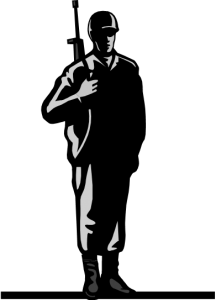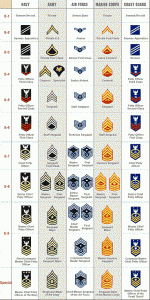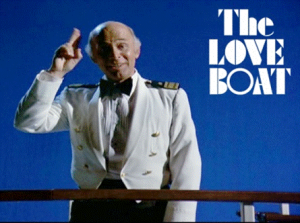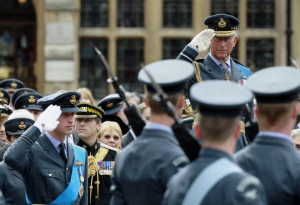 I spent 20 years in the U.S. Air Force, so I’m comfortable discussing U.S. military in general since I served along with all the branches. This will be a multi-part series about the most common things a writer needs to know if they’re going to have military characters or any kind of military items in their books.
I spent 20 years in the U.S. Air Force, so I’m comfortable discussing U.S. military in general since I served along with all the branches. This will be a multi-part series about the most common things a writer needs to know if they’re going to have military characters or any kind of military items in their books.
We’ll discuss basic things that cover all branches of the service. Each branch has distinctive uniforms (which have become more distinctive in the last few years). But there are customs and courtesies that extend across all of them. Deciding if you’re making your characters enlisted or officers greatly changes how you will write the story. Having a mixture of both will give you a challenge but adds to realism.
Here’s the rank structure for all branches of the U.S. military:
Enlisted:

Don’t worry if you can’t see them, links will be provided later.
Officer:

Let’s move on to the salute. Or as it is formally known: Present Arms.
The origins of the modern salute are believed to date back to the era of knights. As a gesture of peace, they would use their right hands and lift the visors of their helmets, making eye contact, and showing they are not a threat. The modern day salute is a version of that movement.
Enlisted salute officers. Officers of lower rank salute officers of higher rank. An officer will never salute an enlisted person first. Rare exception: Medal of Honor recipients may be saluted by officers and enlisted regardless of their rank.
Saluting is normally done outside where you’re required to wear a hat (cover). There are, of course exceptions on when and where to salute:
1. Attending a ceremony that would be held outside, but due to inclement weather is being held indoors. i.e.: Change of Command ceremony. You will wear your hat and salute.
2. Being summoned to an office on official business. It usually means you’re in trouble, and we call that being “called to the carpet.” You won’t be wearing your hat, but you will salute the officer and provide a reporting statement.
3. You do not salute if you’re carrying heavy items and cannot safely render a salute. Instead you offer a greeting. “Good day, Sir/Ma’am.” The officer will salute and offer a greeting back (if they are polite!).
4. If you’re in a work detail, the senior person in the detail will salute for the whole group (who will still come to attention anyway).

Now I can tell you there is nothing more irritating than having an officer return your salute with what we call the “Captain Stubing.” Two fingers don’t cut it!


Next are some basic customs and courtesies. It goes without saying in the military that rank has its privileges (RHIP). If you’re enlisted, you’ll address officers as “Sir or Ma’am.” Sometimes lower ranking enlisted will address higher ranking enlisted by the same, although it tends to irritate the upper enlisted. They prefer to be addressed by their name and rank, or just rank. Such as: MSgt Rowe, or simply MSgt. Occasionally you’ll find some senior enlisted that get a bit “rank heavy” and demand to be called Sir or Ma’am.
The same goes for a lower ranking officer addressing a higher ranking one. When a superior enters the room, lower ranking individuals are expected to stand. Exception: if the person entering the room calls: “At ease, or As you were” upon entering.
When officers and enlisted walk together, the enlisted person is always on the left. Should there be more than one enlisted person walking with an officer, they will fall into rank progression with the highest ranking enlisted person walking next to the officer, and the next lower ranking enlisted walking next to the senior one. If there is a senior and junior officer, the junior takes position on the left. The same goes even for enlisted walking together (but we rarely do it!).
Should you have to enter a vehicle; the junior member always enters first. And the senior member is the last one in and the first one out. This applies to boats, planes, and anything else that moves.
Finally I’ll briefly cover some standard drill movements. These commands are called when mass groups are being marched or in formation. There are two parts to a command: preparatory and execution. The preparatory command is used to “get your attention” such as: “FLIGHT, attention!” The execution part is what you will act on: “Column right, MARCH!”
If you are standing in formation, you’ll have a specific series of commands to listen for:
“Flight (or platoon, squadron, etc) ATTENTION!” You will snap to attention—heels together, toes pointing out at 45 degrees, and hands balled and resting at your sides.
“Flight, PARADE REST!” You will bring your left leg out to shoulder width, arms will bend at the elbows, and hands will be tucked behind your lower back, one palm in the other.
Each formation will have a commander (usually enlisted) in charge of the group, and on most cases a guidon bearer (who holds the unit flag). Those two people are out in front of the flight in positions of honor. If the formation is part of a larger group, you will have officers (unit commanders) in front of the flight commander who will relay orders from the adjutant. Military ceremonies are full of pomp and circumstance, and they can be LONG (sometimes more than an hour) to stand for. It’s not uncommon to have troops faint and “fall out” of formation.
If you can wrap your mind around that the military is actually a cast system, you’ll go a long way in understanding how and why they do the things they do. Much of the military way of doing business is steeped in tradition dating back over a thousand years. Granted some of it has been updated to fit modern needs, but the roots of it are ingrained in the past.
Next time I’ll cover the daunting task of military uniforms. Each service has a distinctive form of dress, and several versions depending on use. The U.S. Navy alone has a staggering number of uniforms. A writer can get in a serious muddle if they don’t know what their characters are wearing! So stay tuned for part two- U.S. military uniforms.
Links for this article:
Saluting:
http://usmilitary.about.com/cs/airforce/a/afcustoms.htm
Ranks:
http://www.defense.gov/about/insignias/
Customs and Courtesies:
Drill and Ceremony:
http://www.drillpad.net/DPindividual.htm
Change of Command:

Very interesting Kathy. Thanks.
I read through it and found it very interesting! thank you for posting a wonderful piece to help others to write about military people and the life.
Nicely done Kathy. I look forward to the rest of the series.
Great info, Kathy. I sure learned a lot. Looking forward to more. I’ve always had trouble with rank order (except when playing Stratego), thanks for the graphics.
Marines don’t salute without a cover. I believe they are the only ones who follow that even when called in for office hours. The exception is a marine under arms. This means they are performing a duty that requires them to carry a sidearm. In this instance even if they are inside they will still be wearing a cover.
The exception to the requirement of under arms is when you step into a medical unit or a church. These are by tradition meant to be free of combat arms.
Corporal Jon Jefferson USMC 89-93 once a Marine always a Marine.
Thanks for the added info. I have worked with some Marines, but mostly AF and Army. Semper Fi!
Kathy: My late father was a WWII veteran, Army artillery officer. This makes me an Army Brat, which is a term of endearment for all of us. At one time, i could tell all the ranks by their insignia, but now I’m lost. The armed forces have changed so much, my father would not approve of many of the changes.
Trust me, after 20 years, I wasn’t approving of changes!
Useful resources. Thanks
Great article, Kathy. Lots of places a writer could make a misstep.
Where were you when I was writing Undertow? I was forced to have my ex-husband (a former Navy petty officer 1st class) beta read for me. 😉 Seriously, Kathy, thanks for the info. Looking forward to the next installment. 🙂
(RHIP even amongst military spouses. I recall another Navy wife saying she had to wait in line at the commissary with a full basket of groceries, while the admiral’s wife got to go first. 😀 )
I had a former Marine co-worker that also had a job off base. He told me that a Colonel’s wife came into the civilian hospital where he worked and DEMANDED to be x-rayed before all the other patients that had been waiting hours before her. His reply: “Sorry, Ma’am, this isn’t the base hospital, you’ll wait your turn.” We fell on the floor laughing and cheered!
Really good post, Kathy, thanks. Do please keep adding those differences between armies as well (like the US and UK salutes) – I never would noticed that!
What a great article. Very helpful. I had no idea you didn’t generally salute indoors.
Valuable information that I can use for my military romance. I was searching the web but not always sure if I interpret it correctly. Thanks for the post.
Glad I could help. If you need anymore info, please feel free to get in contact with me (IU has my email address) and I’ll help you wherever I can.